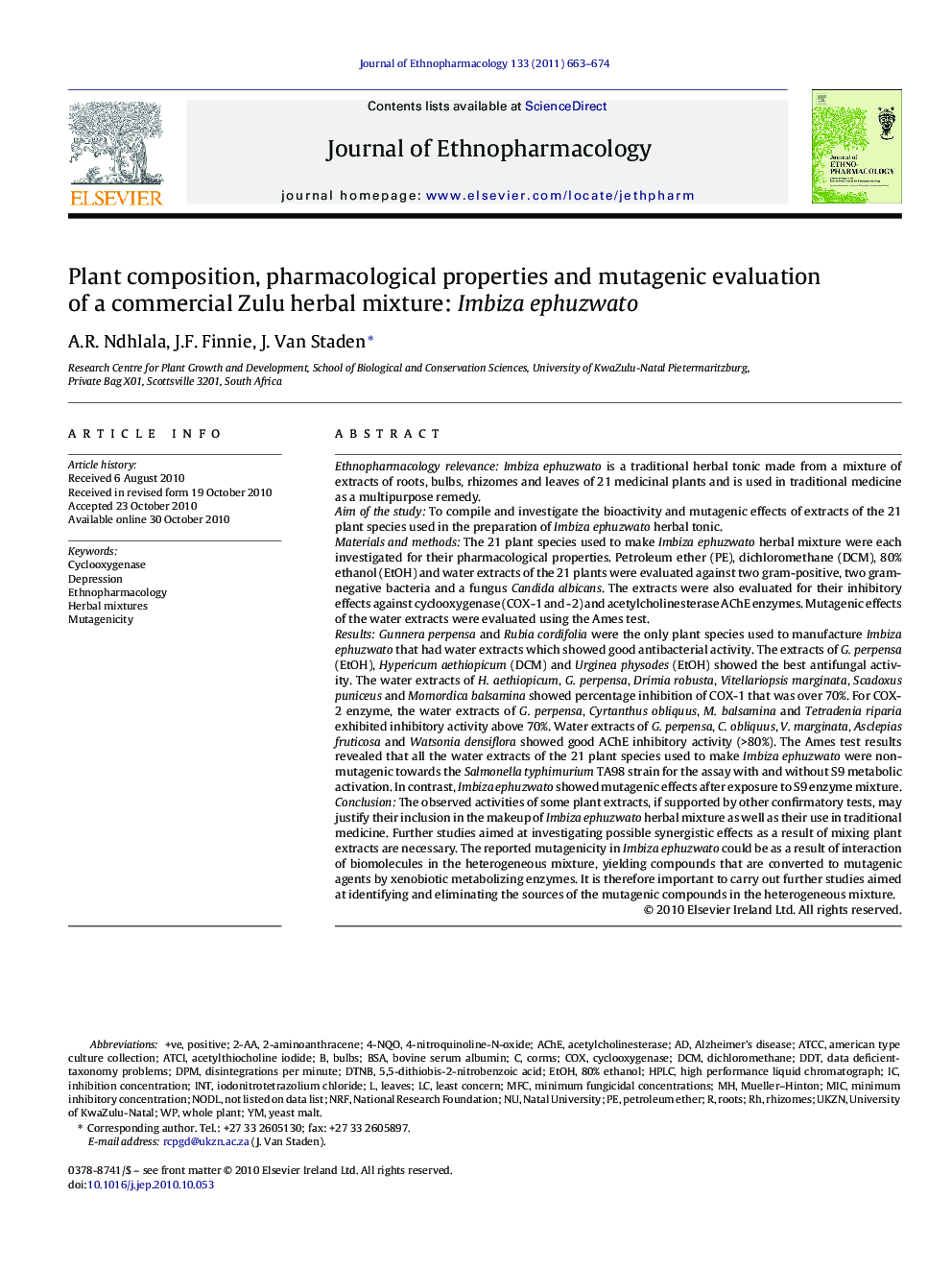| کد مقاله | کد نشریه | سال انتشار | مقاله انگلیسی | نسخه تمام متن |
|---|---|---|---|---|
| 5840058 | 1124004 | 2011 | 12 صفحه PDF | دانلود رایگان |

Ethnopharmacology relevanceImbiza ephuzwato is a traditional herbal tonic made from a mixture of extracts of roots, bulbs, rhizomes and leaves of 21 medicinal plants and is used in traditional medicine as a multipurpose remedy.Aim of the studyTo compile and investigate the bioactivity and mutagenic effects of extracts of the 21 plant species used in the preparation of Imbiza ephuzwato herbal tonic.Materials and methodsThe 21 plant species used to make Imbiza ephuzwato herbal mixture were each investigated for their pharmacological properties. Petroleum ether (PE), dichloromethane (DCM), 80% ethanol (EtOH) and water extracts of the 21 plants were evaluated against two gram-positive, two gram-negative bacteria and a fungus Candida albicans. The extracts were also evaluated for their inhibitory effects against cyclooxygenase (COX-1 and -2) and acetylcholinesterase AChE enzymes. Mutagenic effects of the water extracts were evaluated using the Ames test.ResultsGunnera perpensa and Rubia cordifolia were the only plant species used to manufacture Imbiza ephuzwato that had water extracts which showed good antibacterial activity. The extracts of G. perpensa (EtOH), Hypericum aethiopicum (DCM) and Urginea physodes (EtOH) showed the best antifungal activity. The water extracts of H. aethiopicum, G. perpensa, Drimia robusta, Vitellariopsis marginata, Scadoxus puniceus and Momordica balsamina showed percentage inhibition of COX-1 that was over 70%. For COX-2 enzyme, the water extracts of G. perpensa, Cyrtanthus obliquus, M. balsamina and Tetradenia riparia exhibited inhibitory activity above 70%. Water extracts of G. perpensa, C. obliquus, V. marginata, Asclepias fruticosa and Watsonia densiflora showed good AChE inhibitory activity (>80%). The Ames test results revealed that all the water extracts of the 21 plant species used to make Imbiza ephuzwato were non-mutagenic towards the Salmonella typhimurium TA98 strain for the assay with and without S9 metabolic activation. In contrast, Imbiza ephuzwato showed mutagenic effects after exposure to S9 enzyme mixture.ConclusionThe observed activities of some plant extracts, if supported by other confirmatory tests, may justify their inclusion in the makeup of Imbiza ephuzwato herbal mixture as well as their use in traditional medicine. Further studies aimed at investigating possible synergistic effects as a result of mixing plant extracts are necessary. The reported mutagenicity in Imbiza ephuzwato could be as a result of interaction of biomolecules in the heterogeneous mixture, yielding compounds that are converted to mutagenic agents by xenobiotic metabolizing enzymes. It is therefore important to carry out further studies aimed at identifying and eliminating the sources of the mutagenic compounds in the heterogeneous mixture.
Extracts of 21 plant species used to make Imbiza ephuzwato, a Zulu herbal mixture were each investigated for their pharmacological properties. Several plant species demonstrated good activities which, if supported by other confirmatory tests, justify their inclusion in the makeup of Imbiza ephuzwato herbal mixture as well as their use in traditional medicine.170
Journal: Journal of Ethnopharmacology - Volume 133, Issue 2, 27 January 2011, Pages 663-674